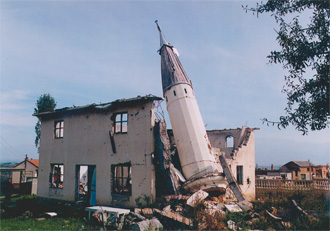Andrew Herscher
Violence Taking Place: The Architecture of the Kosovo Conflict
Stanford University Press
224 pages, 9 x 6 inches
ISBN 978 0804769365
What if the destruction of architecture was understood to be just as complicated, just as culturally resonant, and just as open to interpretation as architecture itself—or, indeed, as any other cultural form? This is the question that Violence Taking Place considers.
The salience of the question emerges from dominant perspectives on destruction, in public culture and the social sciences alike, which often insist on it as either a simple rational act, reducible to the intentions of its author, or an irrational act, completely escaping interpretation at all. What these perspectives each block, in equal but opposites ways, is consideration of the cultural labor that destruction performs—as a social performance, a spatial practice, an object of narrative and a figure of collective imagination.
Violence Taking Place focuses on the former Yugoslavia and, in particular, Kosovo, where the destruction of architecture has been a prominent dimension of political violence. When this destruction has been registered, it is typically understood as a response to architecture’s status as a representation of ethnic or religious identity, territory, or history; destroying architecture becomes, then, a way of symbolically destroying what architecture stands for.
The problem with this sort of interpretation, however, is that it assumes that what architecture stands for can stand alone, without need of architecture or other “representations” to conjure itself into existence. By contrast, I see architecture as a necessary supplement to identity, territory, history and the other phenomena that architecture is typically seen to simply represent.
Violence Taking Place thus suggests that architecture is not so much destroyed in order to destroy what it stands for, but rather to make architecture stand for something in the first place. From this perspective, destruction becomes not a mere epiphenomenon to the forms and forces that make history, but crucial to the constitution of those forms and forces, a constitution which, I suggest, invokes the need for an architectural history of destruction.
The history described in Violence Taking Place places the architectural and urban destruction inflicted during the 1998-99 Kosovo War in a larger context that encompasses modernist urban renewal, structural underdevelopment, refracted colonialism, nationalist conflict and neoliberal reconstruction. In each case, I see destruction as an indispensable component of a historical process.
I also see destruction as a link between historical moments usually perceived in distinct isolation from another. Violence Taking Place thus relates modernist and neoliberal structural violence with transacted forms of political violence, posing new architectural and urban continuities between historically-differentiated periods of “war” and “peace.”

Architecture is not so much destroyed in order to destroy what it stands for, but rather to make architecture stand for something in the first place.
Trained as an architect and an architectural historian, I was led to re-think destruction when I began to survey its remains in Kosovo for the International Criminal Tribunal for the Former Yugoslavia.
For the Tribunal, as for most of destruction’s interpreters, destruction comprised a representation of something else, something that occupied a different level of value, significance and conceptual coherence. For the Tribunal, destruction represented the actions of the alleged perpetrator on trial. For scholarly disciplines, destruction represents the social, political, cultural or ideological dynamic that the discipline in question knows how to study.
Coming to destruction as a historian of architecture, however, I was struck with it as a form of architecture, a kind of architecture-in-reverse, and so possible or even necessary to understand via the particular interpretive protocols of architecture.
Most important to me is the imperative to acknowledge architecture as irreducible to its various contexts—as emerging from but also somehow different than those contexts, as in some ways specific, particular and distinctive in itself. This acknowledgement leads to an understanding of destruction as, like architecture, a form of cultural production, formative of the identities, agencies and contexts that seemingly bear on it as causes.
I argue, then, that destruction should not be approached as a mere surface expression of supposedly deeper contexts and that its analysis shouldn’t rest on mere “contextualization.” Destruction instead ought to be subject to critical interpretation, I suggest, just like architecture and any other cultural form.
Mosque in Reti e Poshtme, Kosovo, dynamited in March 1999. Photograph by Andrew Herscher.

Much of Violence Taking Place appears to be dedicated to violence “over there,” apparently far away—politically if not geographically—from most readers in the Global North.
But in one section of the book, a supplement on NATO’s 1999 air war against Serbia, I suggest that architecture functioned in that war in just the same way as it functioned on the ground in Kosovo—as a way to make manifest otherwise inchoate or invisible presences. For NATO, those presences were the Serbian “war machine,” “command-and-control system,” “military network,” and “infrastructure”—the explicit targets of NATO’s violence. Yet those targets were made available to NATO and subject to destruction by representing them architecturally, as the different sorts of buildings which came to be included in NATO’s every-expanding “target set.”
At the same time, the representation of targets as architecture and not as human beings allowed NATO to leave the human targets of its bombing campaign—both members of Serbian armed forces and civilians alike—unrepresented. NATO represented its war by images like videos shot by cameras mounted on precision-guided weapons or by surveillance photographs that showed buildings before and after they were attacked.
But these images displaced other images and even knowledge of other destruction, inflicted on human beings whose injury or death was only noted as “collateral damage.” Human bodies were often violated in the course of violating buildings; in these cases, then, the videos shot by precision-guided weaponry were snuff films screened as architectural studies.
NATO’s air war was imagined and narrated as a “humanitarian war,” conducted in the name of human rights (those of the Kosovar Albanians besieged in the violent Serbian counter-insurgency) by the seemingly humanitarian means of precision-guided weaponry. The humanitarian nature of the war, however, was a fully architectural production, represented by architecture that seemingly allowed the targets of the war to be attacked and that allowed the human victims of that war to be left invisible.

The representation of targets as architecture and not as human beings allowed NATO to leave the human targets of its bombing campaign—both members of Serbian armed forces and civilians alike—unrepresented.
We’re surrounded by the images and remains of destruction—from the targets of so-called “terrorism” to those of technologically-sophisticated warfare. This material suggests that architecture is no longer what it once was, or at least what it was once said to be—in Walter Benjamin’s famous words, “the prototype of a work of art the reception of which is consummated by a collectivity in a state of distraction.”
Indeed, the intensively visualized NATO air war marked a key moment in the formation of architecture as a privileged mediation of violence and thus, into an object of scrutiny for a public guided by military image capture and aesthetics. In times and places of emergency, in other words, architecture is no longer the object of a distracted perception, but rather a perception that tracks violence, whether with fear, regret, satisfaction, confusion or unease.
During and since the NATO air war, then, a militarized public attention has been fixed on architecture, on buildings whose destruction is threatened, imminent, in process, complete, or anticipated. These buildings are not only destroyed by violence; they also comprise decoys, lures or ruses, substituting for or repressing other sites and sights of violence. There’s no time like the present, then, to scrutinize destruction more closely.
Violence Taking Place tries to suggest how this scrutiny might proceed and, in so doing, reframe our understanding of the violence that destruction often mediates.




We don't put paywalls. We don't distract you with ads. We don't sell your data.
Please help to keep this running!